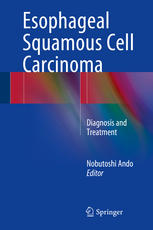مشاهده سبد خرید “The Thorax 2020” به سبد خرید شما اضافه شد.
Esophageal Squamous Cell Carcinoma: Diagnosis and Treatment 2014
دانلود کتاب پزشکی کارسینوم سلول سنگفرشی مری: تشخیص و درمان
دسته: انکولوژی, پزشکی, پزشکی بالینی, جراحی, عمومی, قلب و قفسه سینه, گوارش
ناشر:
Springer Japan
| نویسنده |
Nobutoshi Ando |
|---|
| تعداد صفحهها |
309 |
|---|---|
| نوع فایل |
|
| حجم |
10 Mb |
| سال انتشار |
2014 |
89,000 تومان
دانلود ۳۰.۰۰۰ کتاب پزشکی فقط با قیمت یک کتاب و ۹۹ هزار تومان !
توضیحات
سرطان مری باعث حدود 386000 مرگ در سراسر جهان می شود و ششمین علت شایع مرگ و میر در مردان است. ویژگی های اساسی درمان سرطان مری بین کشورهای آسیایی و غربی به طور قابل توجهی متفاوت است. در بافت شناسی تومور، کارسینوم سلول سنگفرشی مرتبط با مصرف سیگار و الکل در آسیا بیشترین شیوع را دارد، در حالی که آدنوکارسینوم مرتبط با متاپلازی بارت بیشترین شیوع را در غرب دارد. جراحان اصلی ترین افرادی هستند که نقش مهمی در مدیریت بیماران مبتلا به سرطان مری در آسیا و به ویژه در ژاپن دارند. در غرب، این نقشها توسط انکولوژیستها و انکولوژیستها و همچنین جراحان انجام میشود. فلسفه جراحان در مورد جراحی سرطان از کنترل موضعی تا کنترل نئوپلاستیک موضعی، به ویژه در تمرکز بر برش غدد لنفاوی متفاوت است. بنابراین، رویکرد پزشکان به درمان جراحی کمکی بین آسیا و غرب متفاوت است. با توجه به این تفاوتها بین شرق و غرب در درمان سرطان مری، یافتههای موجود در حال حاضر از شواهد غربی نباید مستقیماً برای سرطان مری در آسیا قابل استفاده باشد. در این کتاب، نویسندگان پایگاه دانش در ژاپن در مورد درمان کارسینوم سلول سنگفرشی مری را مورد بحث قرار می دهند. از آنجا که این جلد شامل طیف گسترده ای از اطلاعات جاری است و به موضوعات مرتبط با درمان بیماران مبتلا به سرطان سلول سنگفرشی مری می پردازد، به پزشکان و محققان آسیایی و همچنین همتایان آنها در غرب بسیار مرتبط است.
توضیحات(انگلیسی)
Esophageal cancer causes an estimated 386,000 deaths worldwide and is the sixth most common cause of death for men. The background characteristics of esophageal cancer treatment are markedly different between Asian and Western countries, however. In tumor histology, squamous cell carcinoma associated with smoking and alcohol consumption is overwhelmingly prevalent in Asia, whereas adenocarcinoma associated with Barrett’s metaplasia is markedly prevalent in the West. In Asia, especially in Japan, the key persons who play important roles in the management of esophageal cancer patients are surgeons; in the West those roles are filled by medical and radiation oncologists as well as surgeons. The philosophy of surgeons regarding cancer surgery varies from locoregional to local tumor control, particularly in focusing on lymph node dissection. Physicians’ approach to surgical adjuvant therapy differs, therefore, between Asia and the West. Considering these East–West differences in esophageal cancer treatment, the currently available results of Western evidence should not be considered directly applicable to esophageal cancer in Asia. In this book, the authors discuss the knowledge base in Japan in terms of treatment of esophageal squamous cell carcinoma. Since this volume contains a wide spectrum of current information and addresses topics surrounding the treatment of patients with esophageal squamous cell carcinoma, it is highly relevant to Asian physicians and researchers as well as to their counterparts in the West.




